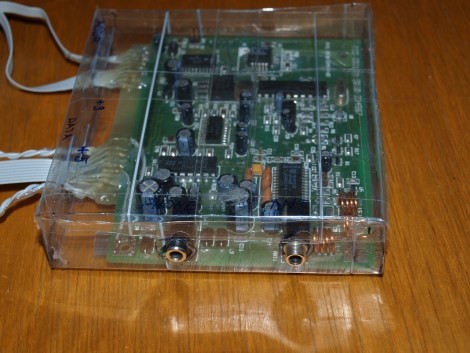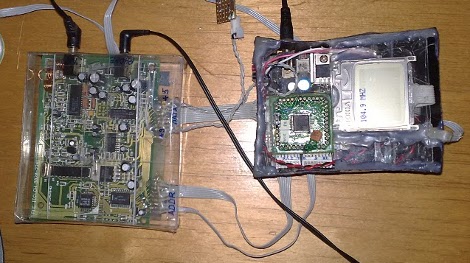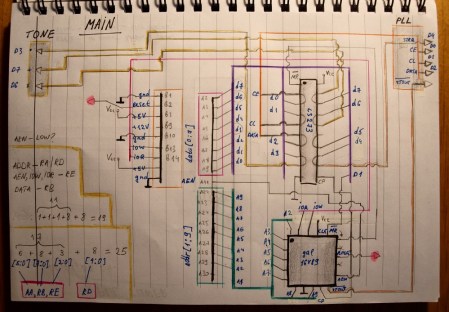
[Alex] had an old FM radio tuner card come his way. It used an ISA connector, a standard that went the way of the dodo in the mid-nineties. With the challenge of implementing an ISA-bus to configure the card he set out on his mission. What he came up with is a working radio using the ISA card and driven by a PIC 16F877. Join us after the break for schematic, code, and a few details.

The card is based on an LM7000 PLL synthesizer paired with a LC7534 tone/volume controller. With a bit of datasheet study [Alex] figured out where the data pins for the chips map to the ISA bus. Working with a prototyping board, the hardest part turned out to be finding the addresses for the chips. He ended up testing all 256 possibilities and watching for the data to be latched from the ISA bus. Alex says the hardware is capable of tuning from about 60MHz up to 125MHz.
We asked him if he’d share his code and schematic. He came through with both, and kudos to him for such a clean hand-drawn schematic. Nice work [Alex]!
Source Code (Tarball)

















I made a terminal once out of an old ISA Hercules card and an 8051 processor.
This was before I had a digital camera, so no pics or anything. I don’t even know where the hardware is anymore. :/
This would be useful for that DIY scan/tunnel microscope that was on here that used an ISA AD/DA
Great work!! I have an old FM card (whatzzat? soundblaster 1.0?) left which I just can’t throw away because of some crazy nostalgic feelings… if I’d only had the time…..
I am going to find where I put my old ISA FM Radio now.
personally I would have soldered to an ISA connector and then plugged in the card, but if you don’t plan on changing the setup, it’s not needed.
Ah yes… the stuff we decide to throw away because it’s no longer useful, or because we decide to emigrate to some country on the other side of the world, and then we realize that we should have all boxed it up and mailed it and it would have become useful if for no other reason than nostalgia…
Well done, and cool multi-color schematic!
I love it !!! I remember throwing all the ISA cards away ….. oh the nostalgic feeling !! Thanks guys :D
“went the way of the dodo in the mid-nineties.”
Lawl. You used the Wikipedia’s dates instead of asking someone who was into PC hardware at the time.
ISA slots were still very much in almost every motherboard until at least 2000.
Nah they started dying off as soon as PCI came in, with maybe a few years of crossover for compatibility. I had a Pentium 233 motherboard, no ISA. My 486 before that was the fabled VIP, Vesa, ISA, PCI.
And towards the end you might get 1 single ISA slot, put there grudgingly, but nobody used them. Maybe a couple of people who had some weird special card they couldn’t replace, but PCI had long-since taken off.
I’d like to have opens source alternative to:
http://www.arstech.com/item-USB-2-0-to-ISA-card-ROHS-usb2isa.html
Wow, very impressive. I have been wanting some sort of generic solution for using old isa hardware for some time now. The best I have done is found a company which makes an ISA bus which attaches to a PC via USB. It is unacceptable for saving ‘junk’ hardware because it is very expensive!
Your project makes me wonder if I shouldn’t just be studying up on the ISA bus and how it worked in order to roll my own…
Well if you buy industrial motherboards many of them have options for isa as it is still used for many io applications.
HAIL the ISA bus!
It’s the most straight-forward bus I’ve ever seen and I’ve also made several ISA cards in the past. Ever since the ISA bus went away (I was able to stretch it to the end of the millennium) I haven’t been able to interface anything useful to my own software running on a PC.
Why not use USB. It’s got more bandwidth than the old ISA bus did anyhow
@Mike:
ISA on nearly every mobo until 2000? Uh, no. I have several machines from 95-98, and not a single one of them has ISA. What mobos were you buying?
Looks interesting, when I have some more time I might look deeper into this as I also have an old ISA FM tuner somewhere in the big cabinets of hardware over here.
I bought an awesome brand-new Epox 8kta3+ with an ISA slot only 7-8 years ago. I plugged a 5 slot ISA riser card into the ISA slot, and had twelve cards running off of that one motherboard. Sorting the interrupts out was a hassle, but I eventually got it sorted out and working perfectly…
In certain industries, ISA is not yet dead. It’s so undead, that there are still companies developing new single board computers for industrial applications that have ISA bus. (Case in point: Core2Duo+ISA http://www.dtims.com/products/pci/lbc9316.php)
ISA is still in wide use in telecom because it just works. Sure, new stuff being deployed is more modern (usually CompactPCI), but existing equipment isn’t going to be replaced unless it fails — and even then it’s usually the SBC not the ISA cards.
ISA isn’t dead yet because the cards themselves won’t die.
“ISA on nearly every mobo until 2000? Uh, no. I have several machines from 95-98, and not a single one of them has ISA. What mobos were you buying?”
open architecture board often had at least 1 for quite a while, the last board with one I can remember was
http://www.motherboard.cz/mb/tyan/Trinity%20100AT.htm
which held my AMD K6/2 350MHZ, and I bought it y2k
compaqs and Hp often sported one in the mid tower machines
http://www.newegg.com/Product/Product.aspx?Item=N82E16815158050&cm_re=isa-_-15-158-050-_-Product
Yes Virginia, there is still a company that makes ISA based serial cards. StarTech’s 2 port 16550 UART based card plugs into any available ISA slot.
Each port is individually configurable as to speed, base address and IRQ setting. The use of jumpers means that it is easy to set and install.
lol
Data Transfer Rate 460.8 Kbits/Sec max.
lol you can get a tv tuner fm tuner combo card for 30 or less. of course for that price you get an analog tv tuner. at least you’re smart enough to figure that shit out and you learned some shit like you might need when you are stuck on mars and have to rip a pci 56k modem out of a dead mars rover to build a communicator or whatever lol i dont remember that movie was forever ago, whatever it was
Intel 440BX motherboards had an ISA slot, and they were sold thru 2000 See the links to reviews and product information of BX motherboards dated 1999 and 2000.
http://www.anandtech.com/show/228
http://www.firingsquad.com/hardware/bf6/default.asp
http://hardware.earthweb.com/chips/article.php/620781
http://www.itox.com/pages/products/mothers/comercialmb/pb50bx.php
Granted these were probably some of the last motherboards with ISA slots so “nearly every” would not be very accurate. Regardless you could buy new motherboards with ISA thru 2000.
madis_l, I was thinking of exactly that when reading about this. Still a pretty cool hack.
I like the enclosure. Neat job
I’ve got a set of ISA card standards around here somewhere.
Arduino ISA shield, anyone?
madis_l: I was kept from upgrading a DCC because of ISA cards, now I can propose it in the future!
tl;dr
I still have an ISA FM card from one of my first PCs. Back then I wanted a controlling application for DOS so badly that I eventually coded one after a few evenings with SoftIce and BPIOs. (Now, of course, one can use Linux drivers as a reference.) When cleaning the attic a few months ago, the idea of a standalone digital radio also crossed my mind, however other ideas prevailed.
I would even do this project solely to learn the ISA bus better. But manufacturers discarded it (and other DIY-friendly concepts like LPT port) long ago, therefore that knowledge has no practical value.
Kudos for the acrylic! I’m still fascinated by the looks of such enclosures, probably because I never built one myself :)
madis_l: +1
Actually, this post remembers me of my early days with a computer and I wish I could bring all the pieces of it back to life.
I think I might want to try and recycle some of my old ISA network cards on a micro controller.
On ISA being dead in the mid 90s old P3 had 2 ISA slots.
I used a USR ISA 56K modem as it was far more reliable the a win modem until I got a cable modem in 2000.
@Nitori of course it was, ‘win modem’ were mostly software, and the CPU’s back then weren’t up to the task really, but you had serial hardware modems and later PCI ones, so it’s a bit unfair to compare a piece of hardware to something mostly software like you do.
I still have a dual PIII Tualatin computer running, and it has an AWE64 ISA as the soundcard. It works perfectly and has onboard amplifier too, so i have the satellite speakers of my diy’d 2.1 system running straight off the soundcard.
Even if i wanted a new soundcard i’d have nowhere to fit it, as one PCI slot is covered by the GPU cooler, and the other three house a network card, USB 2.0 card and SATA controller. That SATA card does wonders for the old PIII.
I never tried interfacing the bus itself (was too young for that), but it would be cool trying that in the future. I have a half-decent ISA video capture card that would be useful as a standalone device.
@saimhe Yeah, about that.. Printer ports are handy since their are still plenty of old parallel port printers hanging around (got a dell laser printer with a parallel port in my basement). The disappearance of the LPT port and serial port is why i’m particularly keen on hanging on to my present computer. It’s a little obsolete right now and has a hard time with more recent games, but it has a parallel and a serial port (integrated into motherboard). It’s only like 6-7 years old now.
shit like you might need when you are stuck on mars and have to rip a pci 56k modem out of a dead mars rover to build a communicator or whatever lol i dont remember that movie was forever ago, whatever it was
@ jeditalian:
That was Red Planet :)
Is there still enough interest in ISA support to justify putting ISA on even one model of a current generation motherboard from a big manufacturer? Industrial board makers do great things, but they want $300 US for something with ISA slots, which would be a lot of money for a top of the line board let alone something that is otherwise comparable feature-wise to a US$50 bargain board.
A little bit of Googling might have saved Alex some reverse-engineering time – like inspecting this short bit of C code from 1995 when the card was new… ftp://sunsite.unc.edu/pub/Linux/apps/sound/radio-cards/fmradio.tgz
Given the lack of ISA slots with all commodity (non-industrial) hardware these days, I think it’s a great hack to drive an 8-bit ISA card from a cheap modern microcontroller. I happen to have one of these cards – I may see what I can do with it from an AVR processor (since I prefer them to PIC MCUs for most stuff). Thanks, Alex, for the inspiration.
It would be nice if that link to the tarball worked…
If you mean the one I posted to fmradio.tgz in July, I just tested it and it still works. Are you perhaps behind a firewall which blocks FTP?
Doesn’t arstech’s usb2isa simply provide the hardware layer.. the user still has to do the usb driver?
Source code tarball link is dead http://blog.mahalo.com/hackaday/misc/ISA-fm-radio.tar.gz
Try: http://ibiblio.org/pub/linux/apps/sound/radio-cards/fmradio.tgz
That’s a fresher link to my link for original software, not the OP’s link to his PIC code. That’s been dead for years.
arstech link http://www.arstech.com/item-USB-2-0-to-ISA-card-ROHS-usb2isa.html is not working … can anybody please provide me the source code and files….